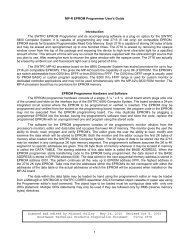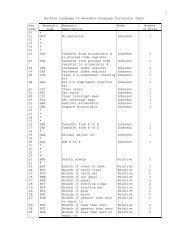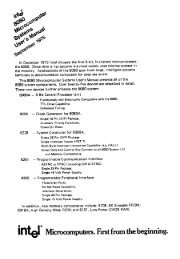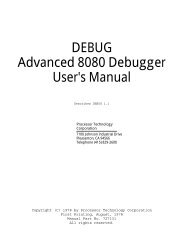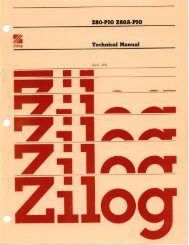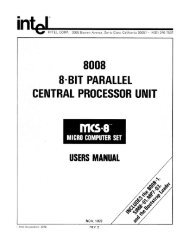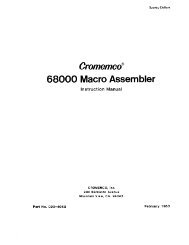The System Manual of SOL-20 - History of Computers
The System Manual of SOL-20 - History of Computers
The System Manual of SOL-20 - History of Computers
Create successful ePaper yourself
Turn your PDF publications into a flip-book with our unique Google optimized e-Paper software.
PROCESSOR TECHNOLOGY CORPORATION<br />
Sol THEORY OF OPERATION<br />
SECTION VIII<br />
<strong>The</strong> PRE_BLANK input provides "window shade" blanking which is<br />
analogous to pulling a window shade down from the top <strong>of</strong> the display.<br />
PRE_BLANK is generated in one half <strong>of</strong> J-!K flip-flop U43. U43 is reset<br />
by the TC output <strong>of</strong> First Screen Position Counter, U11, and set<br />
by VDISP. <strong>The</strong> output on pin 7 <strong>of</strong> U11 is generated by the scrolling<br />
circuitry (to be discussed later) and defines the character row for<br />
which the "window shade" ends. It may begin with any character row<br />
from zero through 14.<br />
<strong>The</strong> remaining video blanking function concerns the output on<br />
pin 14 <strong>of</strong> D flip-flop U42. This signal, COMP_BLANK, is a composite<br />
<strong>of</strong> HDISP and VDISP.<br />
Since there is a two character time delay between Display RAM<br />
addressing and the corresponding video output on pin 6 <strong>of</strong> exclusive<br />
OR gate U74, the horizontal and vertical blanking signals must be delayed<br />
an equal amount. U42, connected as a two-stage shift register,<br />
functions to shift the blanking into synchronization with the video.<br />
Since U42 is clocked by LOAD_CLOCK (which has a period equal to one<br />
character time), COMP_BLANK is delayed two character times from the<br />
input on pin 4 <strong>of</strong> U42. COMP_BLANK is active low during nondisplayable<br />
portions <strong>of</strong> the video scan to override any video input data on<br />
pins I and 2 <strong>of</strong> NOR gate U59. <strong>The</strong> display is thus blanked.<br />
<strong>The</strong> Display RAM consists <strong>of</strong> eight 1K x 1 bit RAM (random access<br />
memory) chips, U14 through U28. All chips are held permanently<br />
enabled by connecting their CE (pin 13) inputs to ground. Memory addressing<br />
is provided through two-to-one multiplexers (U30, U32 and<br />
U12) which select one <strong>of</strong> two display address sources: 1) an external<br />
address on Address Bus bits ADR0-9 and 2) an internal address supplied<br />
by the Subgroup Counter (U31), Group Counter (U33) and the<br />
Beginning Address Counter (U1). <strong>The</strong> function <strong>of</strong> the address bits<br />
associated with each address source is as follows:<br />
1. External address bits ADR0-5 specify the character<br />
position (one <strong>of</strong> 64) in the character row.<br />
2. External address bits ADR6-9 specify the character<br />
row position (one <strong>of</strong> 16) on the display screen.<br />
3. Internal address bits, a total <strong>of</strong> six outputs from<br />
U31 and U33, specify the character position (one<br />
<strong>of</strong> 64) in the character row.<br />
4. Internal address bits, the four outputs from U1,<br />
specify the character row position (one <strong>of</strong> 16) on<br />
the display screen.<br />
VIII-28



